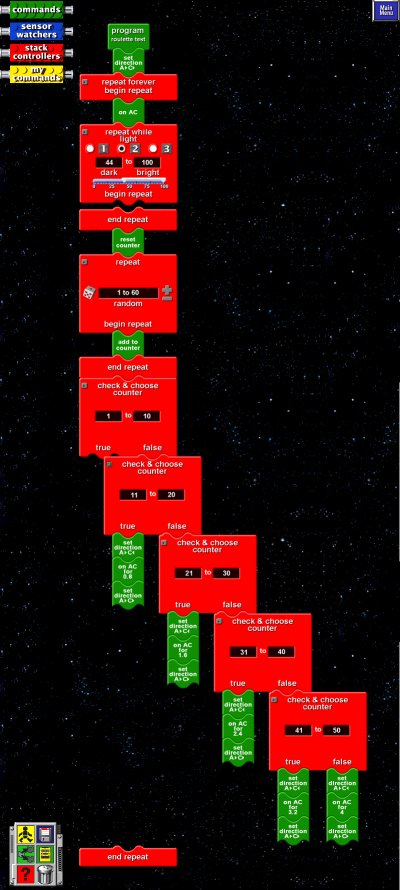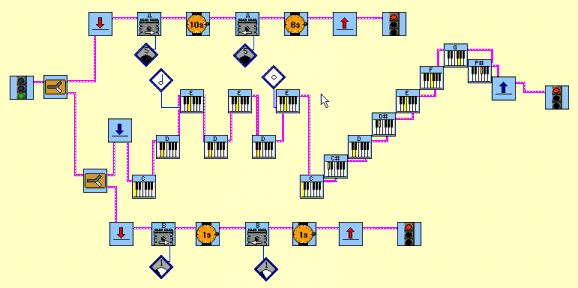Defining the Problem
Researching and Designing
Creating a PrototypeBuilding your Robot
Programming and Testing your Robot
Evaluating your Robot
Defining the Problem
identifying the purpose of a construction
identifying specific requirements
You are confronted with a situation. Here are two examples:
A community wants to construct a robot zoo in which the "animals" move
their heads, open their mouths and make appropriate sounds when they sense that
someone is coming towards them. Design and build a prototype device which could
satisfy this need.
A local pet shop wishes to sell a range of devices which automatically feed
small cage pets (such as rabbits, gerbils, mice etc.) when their owners are away
for the weekend. Design and build a prototype device which could satisfy this
need.
You need to determine what problem you are trying to solve before you
attempt to design and build a robot to solve a problem. Take the time to study a
number of different situations and once you have decided what the situation is
and you understand exactly what the problem is then write a design brief in a
log book (this will be your working document as you work on your robot. This log
book can be a paper notebook or an electronic document.) This is a short
statement which explains the problem that is to be solved.
Researching and Designing
gathering information
identifying specific details of the design which must be satisfied
identifying possible and alternative design solutions
planning and designing a appropriate structure which includes drawings
Having written a brief, you are now ready to gather information which will
help you to produce a successful design. First you will need to decide what
information you require. This will be different from project to project and will
also depend on the amount of information and knowledge you already have. A
useful step will be to use the following chart. Ask the five questions, then
read the column headed Gathering Information. This will help you plan the type
of information you will need to gather.
Gathering Information
1. What is the practical function of the design? (What must my robot do?)A
design's practical functions can include:
movement How will the robot move within its environment? If it were put in
a different environment, would it still be able to move within this new
space?
manipulation How will the robot move or manipulate other objects within its
environment? Can a single robot move or manipulate more than one kind of
object?
energy How is the robot powered? Can it have more than one energy
source?
intelligence How does the robot "think?" What does it mean to say that a
robot "thinks?"
sensing How will my robot "know" or figure out what's in its environment?
If it were put in a different environment, would it be able to figure out this
new environment
2. What part does appearance (shape and form, surface texture, colour,
etc.) play in the design's function? What does the robot look like? Is there a
reason for it to look as it does?Shape and form are important to a design's
aesthetic qualities, ergonomics, strength, stability, rigidity, safety
Surface texture, finish and colour can be appropriate to a
design's:aesthetic qualities, mechanical, optical and thermal properties,
durability, etc.
3. What materials are suitable for the design?The properties of a material
will determine its suitability for a design. For our work with robotics we have
chosen to work with LegoT™. However, there are many different types of materials
that can be and are used in the construction of robots.
strength, hardness, toughness, density
durability
and the aesthetic qualities determined by colour, surface texture, pattern,
etc.
The materials cost and availability are also important factors.
4. What construction methods are appropriate to the design?Construction
techniques fall into the categories of:
cutting and shaping
fabrication - the assembly of the parts using screws, bolts, glues, solder,
etc
moulding - by the application of a force on the material
casting - using a mould to form the shape of a solidifying material
A particular material can only be worked in a limited number of ways. The
method of construction therefore will be determined by the chosen material, the
availability of manufacturing facilities, the skills of the work force and the
production costs.
5. What are the likely social and environmental effects of the design?The
manufacture, use and disposal of any product will have both beneficial and
detrimental effects upon people, wildlife and the environment. The designer
therefore, has an enormous responsibility to consider very carefully the
potential effects of any new design. This will include: health and safety
factors, noise, smell, pollution, etc.
Gathering information can involve reading, listening, conducting interviews
and observing.
A specification is a detailed description of the problem to be solved. It
should 'spell out' exactly what the design must achieve.
Creating a Prototype
testing the design
troubleshooting the design
You should ideally think of at least three different ways to solve the
problem before you concentrate on any one in particular. Sketches and notes are
required at this stage. You can also create prototypes using lego for this step.
Once you have created a lego prototype, take a digital picture of it. Print out
the picture and jot your notes below the picture in your log book. Once you have
settled on one solution, go back over the list of specifications you have made.
Make sure that each specification is satisfied.
Now it the time to produce some working drawings. These are the drawings
that will assist you as you begin constructing the prototype of your structure.
(Here again, lego and a digital camera might be your best friend.) You may
choose to do your drawings by hand or you might want to use a draw program on
the computer to assist you.
Determine a working schedule for yourself. Draw up a timetable showing how
much time you expect to spend on each part of the design process. Your planning
should also ensure that you have all the necessary materials and equipment that
you need to complete your project.
Building your Robot
Construction work can now begin. Here are some sites that help with:
The Art of LEGO Design by Fred Martin - an excellent resource for building
very strong structures
Programming and Testing your Robot
Now it is time to program your robot. This can be achieved in many
different ways. Use can achieve rudimentary intelligence in your robot by using
only relays, potentiometers, bump switches and some discrete components. You can
increase complexity in intelligence in your robot by adding more sensors and
continuing in the same vein of using hardwired logic. By introducing a more
sophisticated control element, the microprocessor, you introduce a significant
new tool in solving the robot control problem. For our robots we used the RCX
Brick that was first developed by Fred Martin at MIT as the Programmable Brick.
See the following two programming examples:
Mindstorms™

Robolab™ has two levels for programming.

Once you have written your program and downloaded into the RCX brick using
the Infrared Sender, it is time to test your robot to see if it truly does what
you want it to do.
Evaluating your Robot
evaluate the design
evaluate the planning process
As building and programming work progresses, and the design begins to take
shape, you will automatically carry out tests on the design. You will also need
to complete systems tests at various stages of the construction. If any of the
tests show that you have failure in a joint, or that part of your structure is
not meeting specifications, then you will have to make modifications in your
plan.
When building and programming is complete, the entire project must be
tested to see if it does the job for which it was designed. An evaluation needs
to then be written. This should be a statement outlining the strengths and
weaknesses in your design. It should describe where you have succeeded and where
you have failed to achieve the aims set out in the specifications.
Here is a list of questions which will help you to prepare this
statement.
How well does the design function?
Does the design look good?
Is the product safe to use?
Did I plan my work adequately?
Did I find the construction straightforward or difficult?
Were the most suitable materials used?
Did it cost more or less than expected?
How could I have improved my design?








